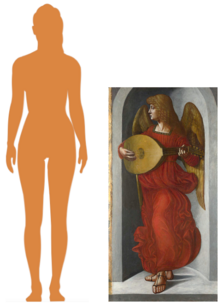
Leonardo di ser Piero da Vinci was an Italian polymath of the High Renaissance who was active as a painter, draughtsman, engineer, scientist, theorist, sculptor, and architect. While his fame initially rested on his achievements as a painter, he has also become known for his notebooks, in which he made drawings and notes on a variety of subjects, including anatomy, astronomy, botany, cartography, painting, and palaeontology. Leonardo is widely regarded to have been a genius who epitomised the Renaissance humanist ideal, and his collective works comprise a contribution to later generations of artists matched only by that of his younger contemporary Michelangelo.

The Virgin of the Rocks, sometimes the Madonna of the Rocks, is the name of two paintings by the Italian Renaissance artist Leonardo da Vinci, of the same subject, with a composition which is identical except for several significant details. The version generally considered the prime version, the earlier of the two, is unrestored and hangs in the Louvre in Paris. The other, which was restored between 2008 and 2010, hangs in the National Gallery, London. The works are often known as the Louvre Virgin of the Rocks and London Virgin of the Rocks respectively. The paintings are both nearly 2 metres high and are painted in oils. Both were originally painted on wooden panels, but the Louvre version has been transferred to canvas.

The Virgin and Child with Saint Anne is an unfinished oil painting by High Renaissance artist Leonardo da Vinci, dated to c. 1501–1519. It depicts Saint Anne, her daughter the Virgin Mary and the infant Jesus. Christ is shown grappling with a sacrificial lamb symbolizing his Passion as the Virgin tries to restrain him. The painting was commissioned as the high altarpiece for the Church of Santissima Annunziata in Florence and its theme had long preoccupied Leonardo.
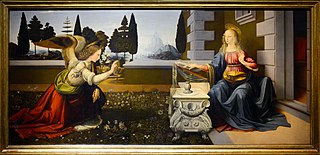
The Annunciation is a painting by the Italian Renaissance artist Leonardo da Vinci, dated to c. 1472–1476. Leonardo's earliest extant major work, it was completed in Florence while he was an apprentice in the studio of Andrea del Verrocchio. The painting was made using oil and tempera on a large poplar panel and depicts the Annunciation, a popular biblical subject in 15th-century Florence. Since 1867 it has been housed in the Uffizi in Florence, the city where it was created. Though the work has been criticized for inaccuracies in its composition, it is among the best-known portrayals of the Annunciation in Christian art.

The Lady with an Ermine is a portrait painting by the Italian Renaissance artist Leonardo da Vinci. Dated to c. 1489–1491, the work is painted in oils on a panel of walnut wood. Its subject is Cecilia Gallerani, a mistress of Ludovico Sforza, Duke of Milan; Leonardo was painter to the Sforza court in Milan at the time of its execution. It is the second of only four surviving portraits of women painted by Leonardo, the others being Ginevra de' Benci, La Belle Ferronnière and the Mona Lisa.

The Madonna Litta is a late 15th-century painting, by Leonardo da Vinci, in the Hermitage Museum, Saint Petersburg. It depicts the Virgin Mary breastfeeding the Christ child, a devotional subject known as the Madonna lactans. The figures are set in a dark interior with two arched openings, as in Leonardo's earlier Madonna of the Carnation, and a mountainous landscape in aerial perspective can be seen beyond. In his left hand Christ holds a goldfinch, which is symbolic of his future Passion.

The Portrait of a Musician is an unfinished painting by the Italian Renaissance artist Leonardo da Vinci, dated to c. 1483–1487. Produced while Leonardo was in Milan, the work is painted in oils, and perhaps tempera, on a small panel of walnut wood. It is his only known male portrait painting, and the identity of its sitter has been closely debated among scholars.

Giovanni Antonio Boltraffio was an Italian painter of the High Renaissance from Lombardy, who worked in the studio of Leonardo da Vinci. Boltraffio and Bernardino Luini are the strongest artistic personalities to emerge from Leonardo's studio. According to Giorgio Vasari, he was of an aristocratic family and was born in Milan.

The lira da braccio was a European bowed string instrument of the Renaissance. It was used by Italian poet-musicians in court in the 15th and 16th centuries to accompany their improvised recitations of lyric and narrative poetry. It is most closely related to the medieval fiddle, or vielle, and like the vielle had a leaf-shaped pegbox with frontal pegs. Fiddles with drone strings are seen beginning in the 9th century, and the instrument continued to develop through the 16th century. In many depictions of the instrument, it is being played by mythological characters, frequently members of angel consorts, and most often by Orpheus and Apollo. The lira da braccio was occasionally used in ensembles, particularly in the intermedi, and may have acted as a proto-continuo instrument.

Giovanni Ambrogio de Predis was an Italian Renaissance painter, illuminator and designer of coins active in Milan. Ambrogio gained a reputation as a portraitist, including as a painter of miniatures, at the court of Ludovico Sforza.

Saint Jerome in the Wilderness is an unfinished painting by the Italian Renaissance artist Leonardo da Vinci, dated c. 1480–1490. A recent study linked to the Lady with an Ermine carried out by Leonardo da Vinci at the same time supports this hypothesis. The composition of the painting has been drafted in monochrome onto the primed wooden panel. At an unknown date after Leonardo's death, the panel was cut into five pieces before eventually being restored into its original form.

Portrait of a Man in Red Chalk is a drawing currently in the collection of the Royal Library of Turin. It is widely, though not universally, accepted as a self-portrait of the Renaissance artist Leonardo da Vinci. It is thought that da Vinci drew this self-portrait at about the age of 60. The portrait has been extensively reproduced and has become an iconic representation of him as a polymath or "Renaissance man". Despite this, some historians and scholars disagree as to the true identity of the sitter.

Bernardino de 'Conti was an Italian Renaissance painter, born in 1465 in Castelseprio and died around 1525.

La Scapigliata is an unfinished painting generally attributed to the Italian High Renaissance artist Leonardo da Vinci, and dated c. 1506–1508. Painted in oil, umber, and white lead pigments on a small poplar wood panel, its attribution remains controversial, with several experts attributing the work to a pupil of Leonardo. The painting has been admired for its captivating beauty, mysterious demeanor, and mastery of sfumato.

The Leonardeschi were the large group of artists who worked in the studio of, or under the influence of, Leonardo da Vinci. They were artists of Italian Renaissance painting, although his influence extended to many countries within Europe.
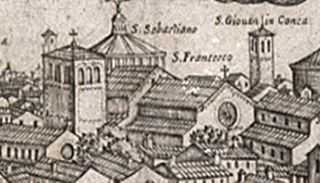
The Church of San Francesco Grande was an ancient church in Milan built in the 4th century and demolished in 1806. It was originally called Basilica di San Nabore after the saint whose remains it houses, but from the 13th century onwards, as the adjoining Franciscan monastery took possession of the monument, it took its new name from Francis of Assisi, founder of the order.

Studies of an Infant is a set of eight red chalk drawings on red ochre-prepared paper by Leonardo da Vinci, housed in the Gallerie dell'Accademia in Venice. These are representations of all or part of the body of a very young child, considered to be preparatory studies for the Infant Jesus in the oil painting The Virgin and Child with Saint Anne in the Louvre.
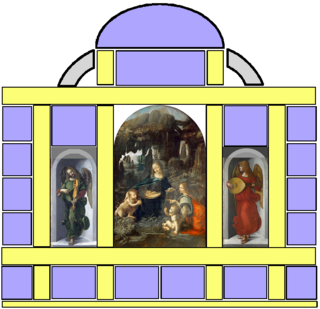
The altarpiece in the Chapel of the Immaculate Conception in the Church of San Francesco Grande, Milan, was an altarpiece built between 1480 and 1482, decorated between 1483 and 1508, and dismantled in the early 19th century.
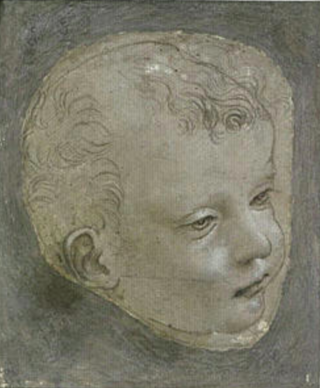
The Tête d'enfant de trois quarts à droite is a silverpoint drawing on paper by the Florentine painter Leonardo da Vinci. It belongs to the Codex Vallardi and is preserved at the Department of Graphic Arts of the Louvre Museum in Paris.


